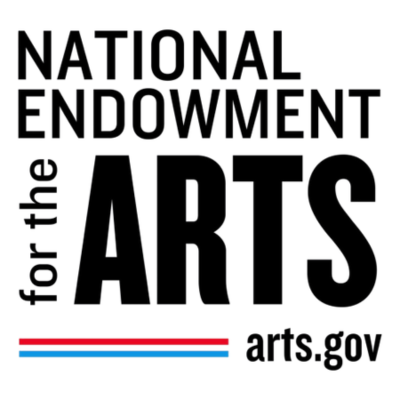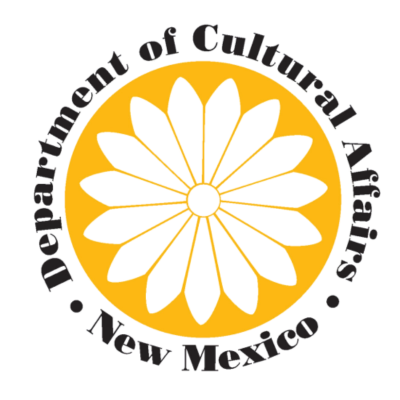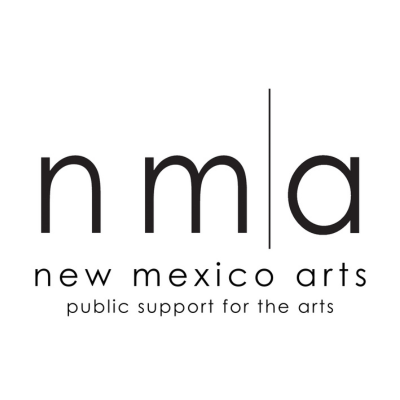Learning Guide
Help us improve our
Learning Guide!
At The Children’s Hour, we are constantly working to improve our work and tools for educators. It helps us to hear from users to make these guides the best they can be, and to collect your feedback.
Thanks for taking our brief survey after you use our guides.
Katie Stone & Lorraine Archibald
Grade Levels
4-8
Subjects
Language Arts, Science, Social Studies, Health, Art, Media Literacy
Grade Levels
4-8
Subjects
Language Arts, Science, Social Studies, Math, Art, Media Literacy
Folk Art Learning Guide

Kids Crew reporter Thorfin stands at a booth to interview an artist.
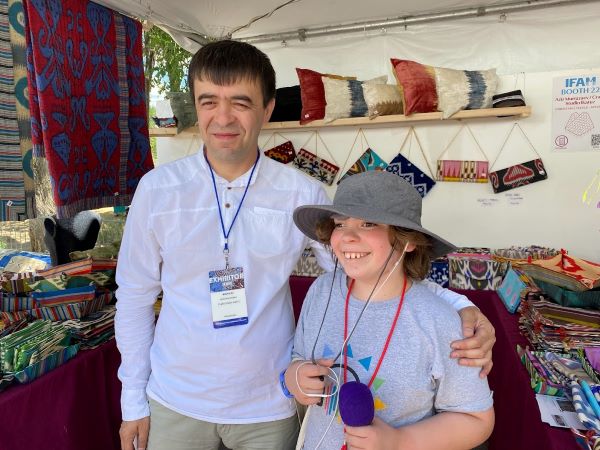
Kids Crew reporter Thorfin stands with an artist from Uzbekistan.
Thanks for listening to our episode about Folk Art, where Katie and the Kids Crew take The Children’s Hour to the Santa Fe International Folk Art Market. It is the largest market of its kind, and brings in more money for its invited artists, than any other folk art market in the world!
In the show we learned about a variety of forms of art and craftmanship from artists of many different countries. Through unique and incredibly interviews, we learn about people, culture, history, and knowledges that are passed down through generations and the stories that are and can be told through Folk Art. Learn more about what you heard and complete fun activities by reading on below!
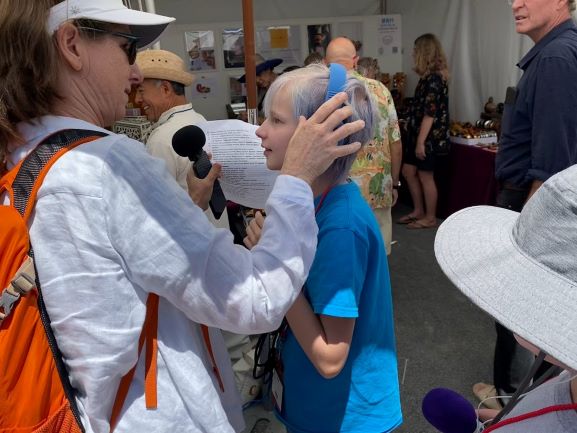
Kids Crew reporter Jo and Katie Stone prepare equiptment for interviews.
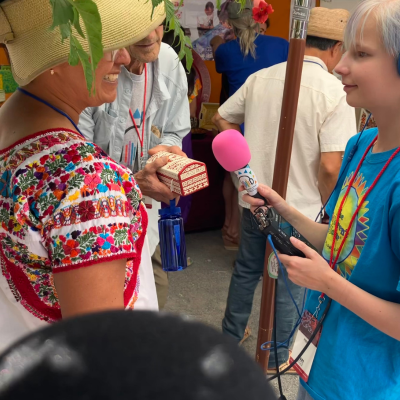
Kids Crew reporter Jo Interviews an artist from Guatemala.
Artisan
A skilled worker who makes things by hand. Often the skills are passed on through family generations.
Textile
A fiber based fabric material that can come from plants, animals, and insects, and is created by processes such as weaving, knitting, and dyeing.
Vocabulary
Vocabulary words can be found throughout the page in bold.
Folk Art
Art that reflects the life, history, geography, stories, and culture of a community. It is art that is inspired by and/or repeats ancient and traditional techniques and design of a specific place or people. Usually is hand made from natural materials, and may be decorative or utilitarian which means its meant be used for a purpose or function.
Craftsmanship
Having skill in a craft, the time, ability, quality, and design of work that goes into the creation of an object including art.
Retablo
A frame, box, or shelf that can be opened to reveal figures, scenes, and imagery that represent religious and/or cultural themes and events. They are very detailed, colorful, and often used to decorate altars.
Folk Art: Traditions Passed on Through Generations
Folk Art is art that reflects the life, history, geography, stories, and culture of a community. It is art that is inspired by and/or repeats ancient and traditional techniques and design of a specific place or people. Usually it is hand made from natural materials, and it may be decorative or utilitarian which means it’s meant to be used for a purpose or function. People who create folk art are not only artists, but also artisans, skilled workers who make things by hand.
Folk art represents not only skill and beauty, but it tells us about the local and regional identity of a place and its people. You can find out more about the people through their folk art by learning more about the meanings behind specific symbols, animals, materials, colors, sounds, and more.
Some people have claimed that folk art is not equal to fine art because its artists may lack formal training from an art institution, or it may be perceived as having less refined than fine art, but folk art is worthy of dignity and high respect due to its quality and craftsmanship, as well as the amount of time and knowledge that goes into it. Over the past hundred years, people have grown to respect folk art more and more and consider it a very valuable form of art.
Many rural or indigenous (Native American) communities express themselves through folk art. It is also valuable and important because it allows for the preservation, or saving of cultural knowledges and traditions. . Folk art is often taught by family members passing down and teaching the techniques to younger generations, for many communities, this type of teaching has been passed down for thousands of years. Folk art has an amazing power to tell stories and teach lessons. What stories would you tell and what lessons would you teach to your future generations?
Guiding Questions
Answer these questions as you read:
1. What is folk art?
2. How can folk art teach us about the culture of a place and its people?
3. What makes folk art so valuable?
Discussion Challenge: Is it Art?
Look at the images below of Celtic pottery. Do you think the items in the picture on the left are “art”, what about the one on the right? Create an argument and explain your reasoning to someone who may disagree with you.
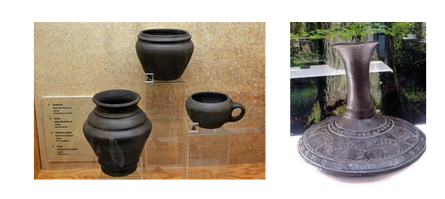
Art and Natural Resources
Evidence of ancient artifacts, or objects made by people, represent high levels of creativity, design, and artistic skill. Many objects related to traditional or folk art are things that have a function, such as pottery, tools, body art, textiles, clothes and more.
When you imagine human history and our relationship to the world around us, you can imagine how art and objects were made from raw, natural materials that are found in nature, such as wood, clay, plant and animal materials, water, rocks, etc. Since each location in the world has a unique and specific geography, different materials emerge through art of different cultures.
As some of our artists discussed in the show, the increase of industrialized (or things made with the use of machines) goods has put pressure on artists to use cheaper and faster materials and techniques, and artificial or chemically produced dyes, paints, and other materials. What makes folk art so special is that it often stays true to elements of how it was originally produced, even though it costs more time, money, and effort for the artist. In order for folk artists to be able to continue these practices, all people need to help support the climate of the planet so that natural resources can continue to be available. Art collectors can also chose to support a folk artist instead of buying an object made through industrialization.
Image Challenge: Can you match the pair of natural materials with the folk art that is made from them and produced by artists you heard from on our show? Extra challenge, determine the location of origin from the map and from what you heard.
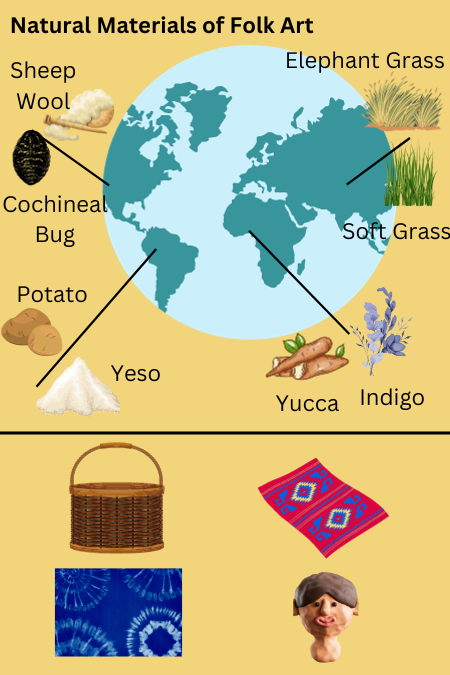
Infographic created with canva.
Activity: Make art out of natural materials
First think: How does your town’s geography determine what natural materials are available? What kind of different materials could you find in your local forests, lakes, deserts, oceans, rivers, or parks?
With the help of an adult, go outside your home or school and look around to find natural materials. Visit a natural area near you and collect more materials. Think about what you would like to create, will it be two-dimensional like a collage on paper, or three-dimensional, like a sculpture?
Then, using regular art materials to help you such as glue, create an original piece of art that uses the natural materials you’ve collected. In addition or instead, consider collecting natural materials, arranging them to how you’d like, take a picture of your creation, then return the materials back to nature.
Textile Folk Art
In this episode, we heard from many textile artists from across the globe. A textile is a fiber based fabric material that can come from plants, animals, and insects, and is created by processes such as weaving, knitting, and dyeing. We heard Gasali Adeyemo, an artist from Nigeria talk about the importance of Indigo in his culture, a plant that provides a unique blue/purple color, and about the complex and delicate process of tie dyeing.
We also heard from Armando Ortega, of Chimayo New Mexico, who described the process of weaving, how to set up and use a loom, and how the weaving tradition of his community has changed while also staying the same. What changes is what is popular in terms of designs and colors, and that he began to recycle materials of his ancestors to create a new type of weaving style, but what stays the same is that he feels connected to his ancestors when he creates his art, and he appreciates the durability, (or ability to last for a long time), of the rugs that he and his community has created.
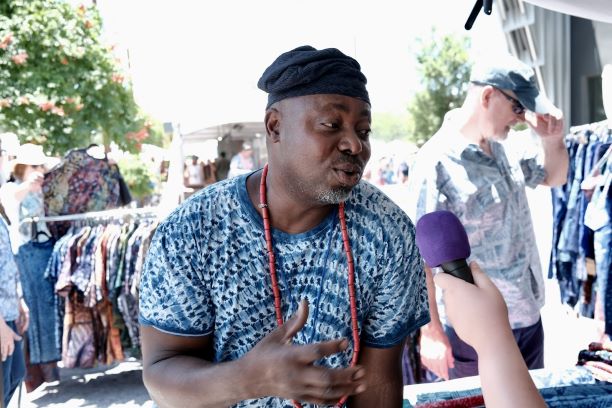
Gasali Adeyemo speaks to kids crew reporter describing his art.
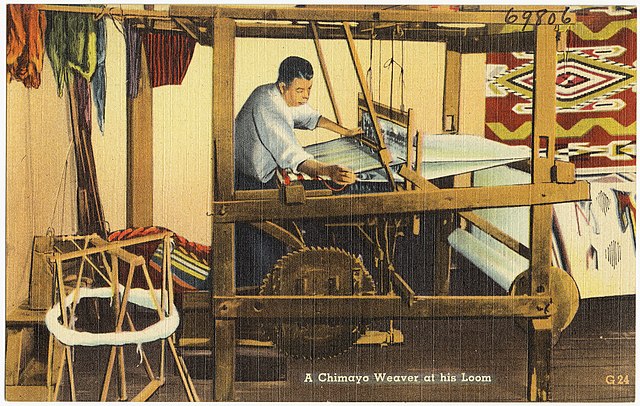
A chimayo weaver at his loom. Image Source
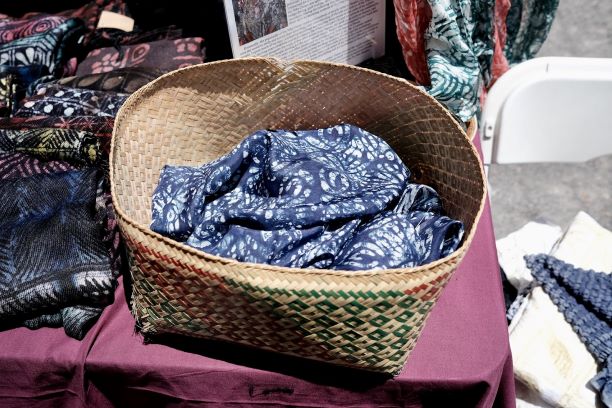
Yoruba, or traditional Nigerian tie dyed textile.
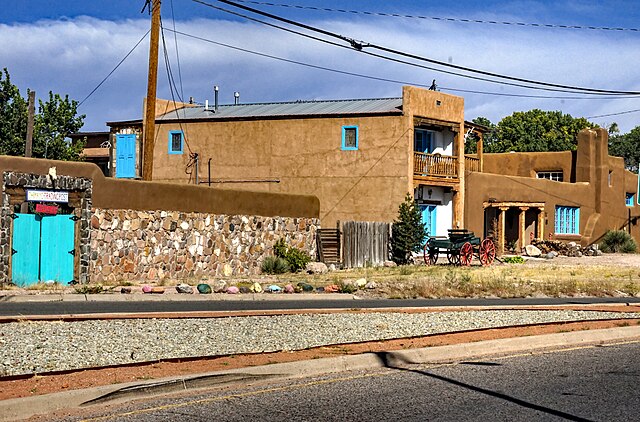
Trading post in Chimayo, New Mexico, where rugs have been sold and traded for generations. Image Source
Folk art comes from calculations and experiments
Cultures and groups of people will have had to have successful and stable societies in order to have the time and resources to create art, therefore folk art also tells us that previous generations of people were highly advanced. Math, just as much as science, is a very important aspect of folk art. Even thousands of years ago folk artists understood the importance of concepts like chemistry, physics, and engineering when creating art. Some forms of art, such as architecture (the design, planning and building of structures and places) invites the artist to create scale models, or exact mini versions of larger things.
On the show, we met Marzena Dłużniewska, a polish artist who is inspired by the architecture of her city and the knowledge of her ancestors. She was trained in the techniques of building Szopki which are intricately designed scale models of actual buildings. Like many others where she is from, she was taught by her family who has passed it down through generations. Her art requires high levels of craftsmanship– the ability, quality, and design of work that goes into the creation of an object including art. She must make precise calculations in her planning so that the dimensions represent the original structure while also understanding the impact of the materials she’s using.
We also learned about another type of folk art that requires knowledge of math and science, and high level of craftsmanship, when we met Jabulile Nala, ceramicist who creates pottery rooted in the traditions of the Zulu tribe of South Africa. She described her multi-step process of first digging red clay from mine, later sifting and grinding it, soaking in water then kneading like bread, making coils, building by combining coils, shaving the pot, then when its dry enough to handle she takes instrument and make incisions, and finally fires it and covers it with polish. Imagine all of the experimenting and problem solving that her ancestors went through in order to get the process just right. Interestingly, this traditional pottery also relates to math in that certain elements of its design like the “bumps” help to calculate wealth and help tell that information. Other design elements such as triangles are there to make the art interesting and help serve a function of creating more grip when using the pot.
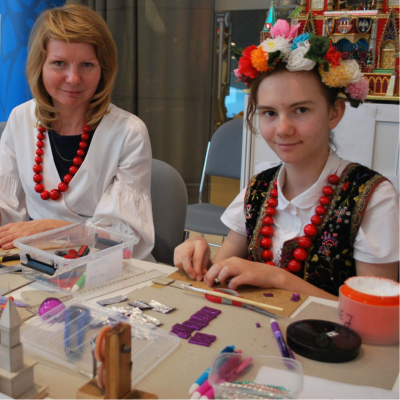
Artist Marzena Dłużniewska and her dauther demonstrate part of their process. Image source
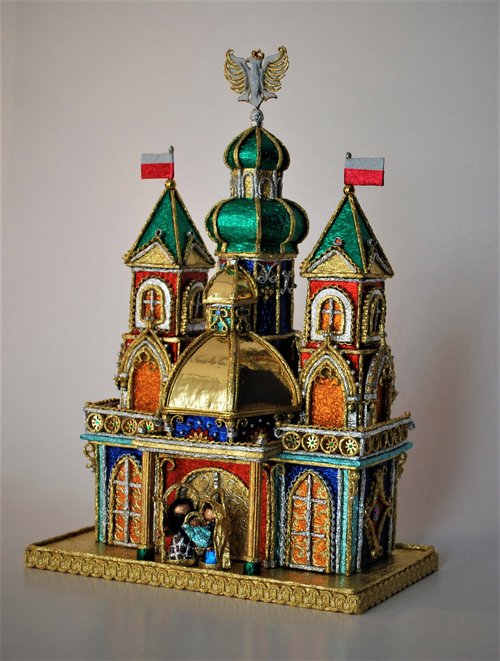
A Szopka or nativity scene, is a tradition originating from Kraków, Poland. Image source
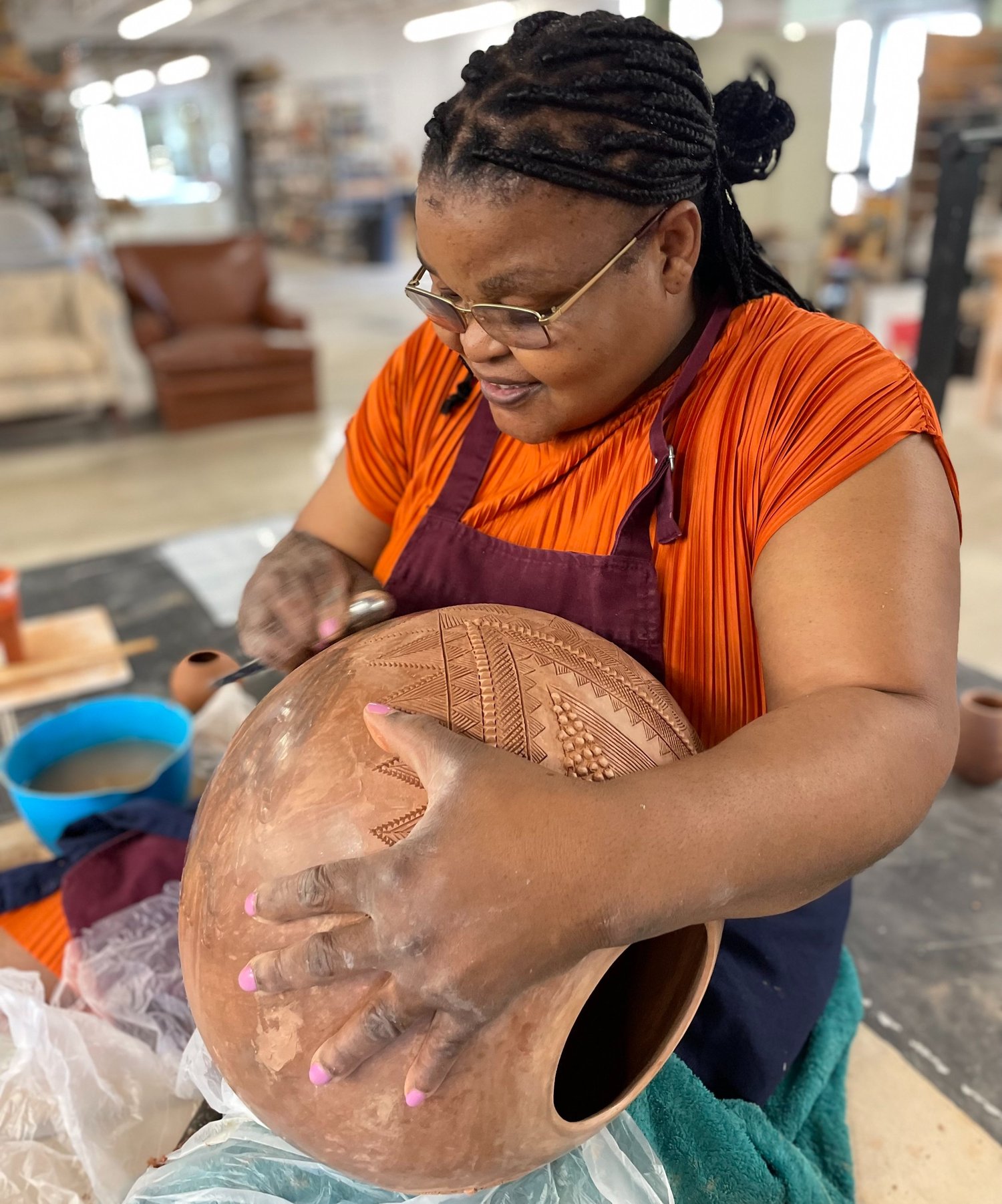
Artist Jabulile Nala creates her pottery. Image source
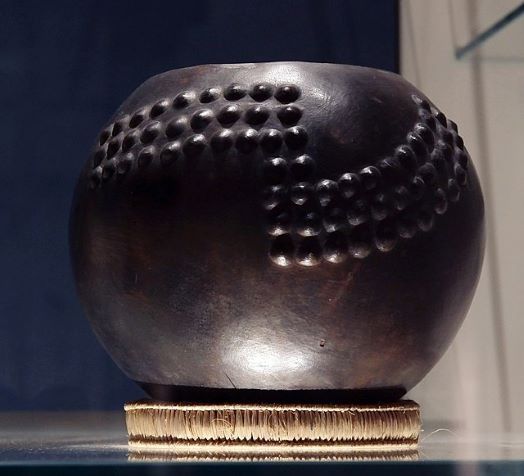
Pottery of the Zulu tribe, with details of bumps. Image source
Activity: Create a scale model
Select any large item that you can find in your house or school, or a small structure such as a dog house, shed, or swingset. Then, use this lesson guide to learn how to calculate and build a scale model of your object. As you build, think about how you will add creativity to your project by including color and design.
Activity: My life in numbers- pottery design
Use this template to design pottery that tells and shares information about your life. Using symbols and patterns, describe the amount of things you have. Be sure to include elements of design and function as you wish.
Storytelling: Culture and history told through Retablos
Folk art serves a purpose of teaching and telling a story. Though most folk art following traditional techniques passed down through generations, folk artists of today also feel the need to express the ways in which their cultures and traditions have transformed. They do this by creating art that uses indigenous and colonial traditions but also mixes in contemporary themes and designs. One example of this is the work of Retablo artist Claudio Jimenez Quispe from Peru. A retablo (Spanish word) is a frame, box, or shelf that can be opened to reveal figures, scenes, and imagery that represent religious and/or cultural themes and events. They are very detailed, colorful, and often used to decorate altars.
The work of Claudio is a way to learn about the history of Peru. First there were the native cultures, like those who were part of the incan empire, whose symbols such as the sun, and animals such as the llama, were very important to the culture and religion over 500 years ago. Then, the Spanish came from Europe and colonized the people of this region and they imposed the Catholic religion on them. The Retablos are a mix of Catholic and Indigenous symbols, just as Peruvian culture is too.
The tradition of Retablos Ayacuchanos is rooted in the use of natural materials like potato starch and wood, to create elaborate detailed scenes that can be revealed behind a door as a wooden box. The retablo San Marcos, described by the artist who the kids crew interviewed, takes on the classic style of representing a religious figure, in the case, the patron saint of cattle, on the top shelf, and the bottom shelf represents a festival or party that is taking place in honor of the season and of cattle. Artists like Claudio, his siblings and his father, are famous for transforming the traditional themes and scenes and also creating retablos that tell other stories, such as stories about important events including battles, community gatherings, relationships and more.
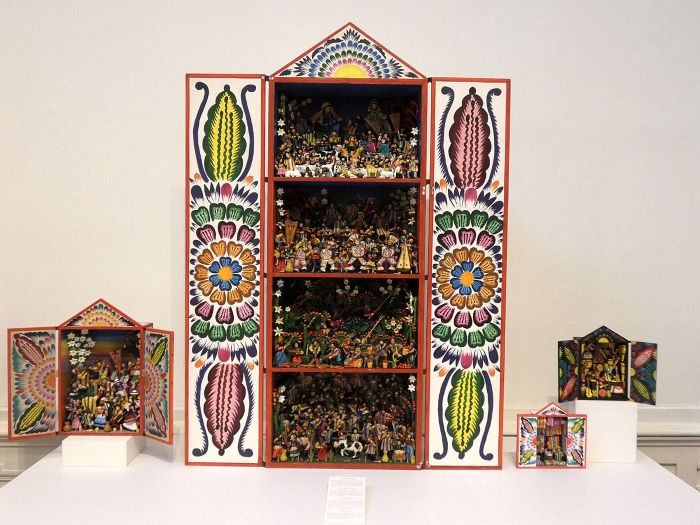
Variety of Retablos picturing different types of events. Image Source
Activity: Tell the story of an event through diorama
Dioramas, similarly to Retablo’s, are physical boxes built to teach or show details about a specific topic. For this activity, think about an important event that you experienced in your life or any important historical event that you want to teach others about.
Using a shoebox or creating your own box, gather art supplies, create material subjects such as figures, and create a diorama about the event you chose. Be sure to think about the background of your event, include many details, and be creative. Display your work and teach others about your story and the lessons that can be learned from it.
Media Journal: Folk Art
After watching one or both of the videos, use the guiding questions to reflect on what you learned. Share your information with another person.
What did I already know about this topic?
What did I learn from the video?
What new questions do I have?
More Activities and Resources
Check out these folk art activities inspired by places all around the world.
Create DIY folk art from the Museum of International Folk Art
Kid friendly history of folk music and how it was brought to different places across the globe.
Follow this lesson from the Sam Noble Museum to create art from natural materials.
Interact with your favorite classic folk songs by giving them your own twist with this activity.
Check out Ukranian folk art lesson for children.
Create multicultural art crafts with these activities.
Use this Brittanica article for conducting research to learn more about types, styles, and regions of folk art.
Follow the Folk genre page on NPR to hear new and old music from folk artists.
This episode and learning guide was made possible from support from these sponsors:
